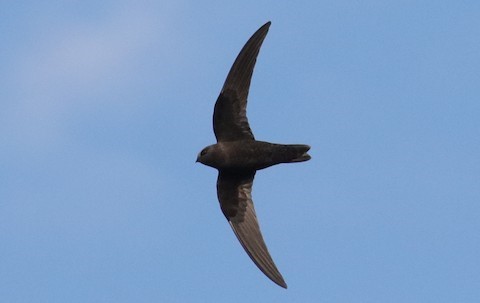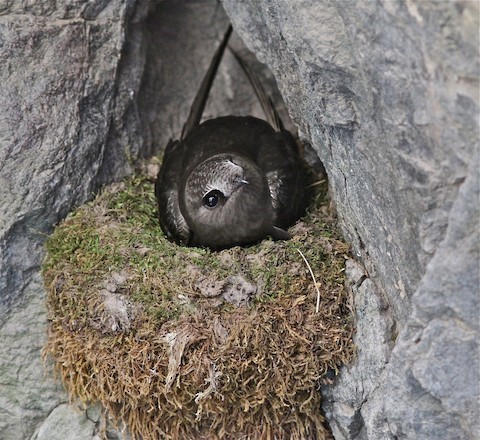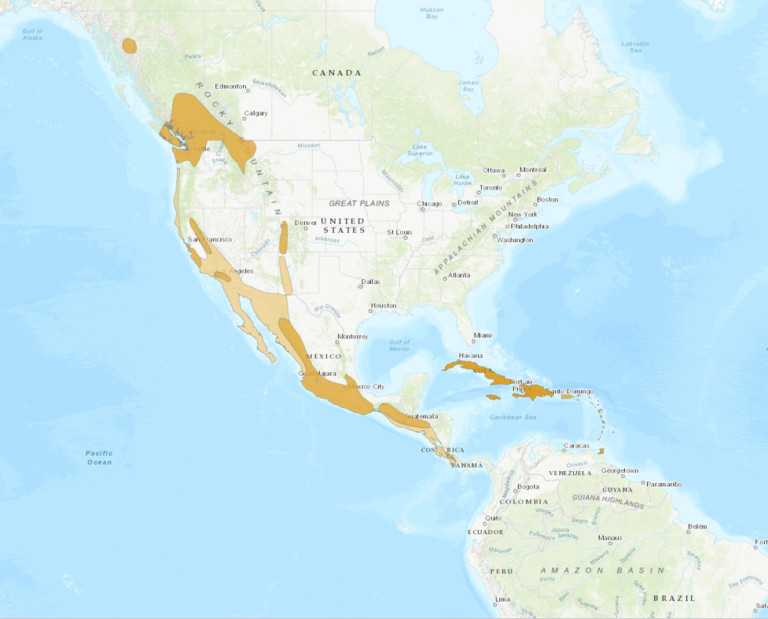Birdfinding.info ⇒ Uncommon and localized across its large range. The highest breeding densities are in southwestern British Columbia (see Breeding Bird Survey Abundance Map in Notes, below), where it can be found at many sites in and around Vancouver, on Vancouver Island, and in the interior. In the U.S., accessible breeding areas include: in Washington, Newhalem, Lake Wenatchee State Park, and Snoqualmie Falls; in Oregon, Salt Creek Falls; in California, Andrew Molera State Park, Año Nuevo State Park, Claremont Wilderness Park, Macarthur-Burney Falls Memorial, Monkeyface Falls, and Yosemite Valley; in Montana, Glacier National Park; in Utah, Little Cottonwood Canyon; in Colorado, Box Canyon Falls Park, Treasure Falls, and Zapata Falls; and in New Mexico, Jemez Falls. On Cuba, Topes de Collantes National Park appears to be a consistent site; on Jamaica, Hardwar Gap; and on Puerto Rico, El Yunque National Forest. In Mexico, it can be found in southern Mexico City (Pedregal de San Angel Ecological Reserve), Mexiquillo National Park, and Xalapa, Veracruz. In Costa Rica, it is seen year-round in several areas, including the San José metropolitan area and Volcán Arenal National Park.
American Black Swift
Cypseloides niger
Breeds from western North America to Panama and the West Indies; winters in the West Indies, Central America, and northern South America.
Breeding. Nests in small colonies in mountain caves, behind waterfalls, and on inaccessible sea cliffs. Typically forages near nest sites, often at fairly high altitudes, but also descends to lower levels, especially during wet weather.
In approximate terms, its breeding areas fall into seven regional clusters:
1) The Pacific Northwest from southeastern Alaska (north to the Stikine River Delta) south through the Olympic Peninsula and Cascade Mountains of Washington and east across most of southern British Columbia and Washington State to the Rocky Mountains of southwestern Alberta and northwestern Montana.
2) California’s coastal ranges and Sierra Nevada south to the San Bernardino Mountains and north to Mount Shasta, with at least one outpost colony in central Oregon.
3) Western and central Colorado, plus a few sites in Utah and New Mexico.
4) Middle America from central Chihuahua and Hidalgo south locally to central Honduras.
5) Costa Rica’s central highlands—and possibly also in western Panama.
6) The Greater Antilles, in mountains of Cuba, Jamaica, Hispaniola, and Puerto Rico.
7) The Lesser Antilles from Guadeloupe to Grenada and Barbados—and possibly also on Trinidad.
Nonbreeding. Rarely observed and little-known outside of the breeding season. Studies using tracking devices have determined that some North American breeders winter in central Amazonia.
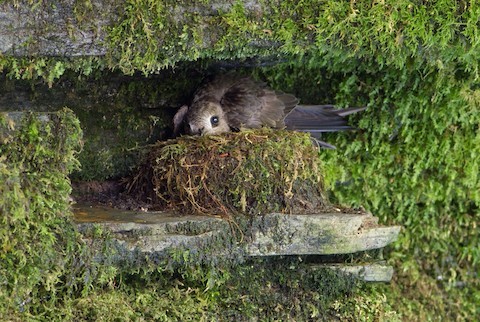
American Black Swift, C. n. borealis, nesting behind a waterfall in Idaho. (Shadow Falls, Shoshone County, Idaho; July 26, 2012.) © Darren Clark
It has been detected in Costa Rica and Panama throughout the winter months, more widely than they are known to breed there, which suggests that some migrants overwinter. There are also apparent winter records from intermontane valleys of the Colombian Andes.
Some portion of the West Indian populations is thought to be resident, especially those on Cuba, Jamaica, and Hispaniola, but also at least occasionally on Puerto Rico and St. Lucia. Some portion is migratory, as migrating flocks are sometimes seen in transit over the Leeward Islands.
Movements. Seasonal presence at breeding sites varies across its wide latitudinal range. In the Pacific Northwest, it typically arrives in mid-to-late-May and departs in August and September.
On its northward migration, flocks are sometimes detected between Costa Rica and southern Mexico in March and April. Farther north, most migration appears to be occur in a relatively compressed period, from late April to late May, but without being highly synchronized.
Departure from northern colonies begins in mid-August, but flocks tend to wander locally before heading south. Most leave the Pacific Northwest in mid-September and the southwestern U.S. by early October.
Vagrants occasionally stray to eastern North America, though there are relatively few confirmed records. Sites where it has been recorded include Fort Morgan, Alabama (mid-April), Point Pelee and Long Point, Ontario (both mid-May), Cape May, New Jersey (late August), and Bermuda (twice in mid-May).
Identification
A medium-large, dark-brown swift with a fairly long tail, typically with a discernible notch.
Tail shape is often the best diagnostic feature, but it varies. In general, males are believed to have more distinctly notched tails than females. In all cases, the potential for the tail to appear notched changes with its posture: when held tight, the tail usually shows a distinct notch; when fully spread, it appears square or rounded.
In the temperate portions of its range, it is the largest, darkest swift, and the only one that typically shows a tail-notch. Across the Neotropical portions of its range, it is intermediate in size between two much commoner groups of swifts, the very large Streptoprocne (especially White-collared) and the small Chaetura swifts and palm-swifts.
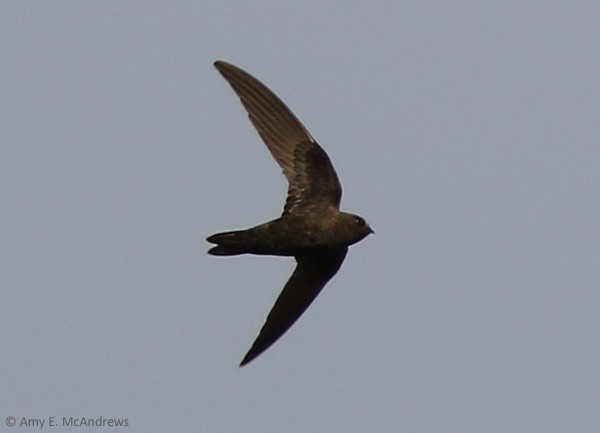
American Black Swift, C. n. borealis, showing generally blackish-brown plumage and characteristic flight silhouette: long wings, long body, and notched tail. (La Mina, Durango, Mexico; June 26, 2016.) © Amy McAndrews
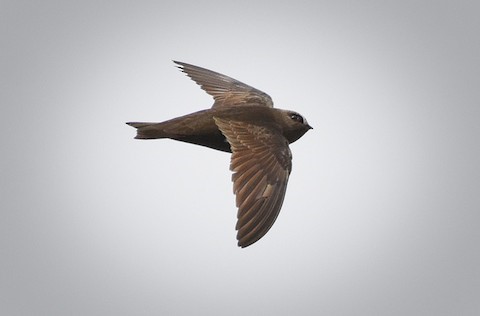
American Black Swift, C. n. borealis, showing all-brown upperparts. (Salmon Arm, British Columbia; June 4, 2018.) © Roger Beardmore

American Black Swift, C. n. borealis, appearing atypically short, stout, and square-tailed. (Willband Creek Park, Abbottsford, British Columbia; June 23, 2018.) © Gord Gadsden
Can appear all-black, as its name suggests, in some plumages and lighting, but often shows contrasting pale areas on the face and underparts.
On the face: the forehead and brow often appear sharply paler, either pale-brown or whitish. In some cases, the throat may also appear paler, but the is not usually a strong contrast.
On the underparts: freshly molted feathers on the belly often show pale tips, giving it an orderly white-spotted appearance. In some individuals, at some angles of view, this effect is quite pronounced. In such cases, it can appear to have a mostly white belly, or a solid whitish band across the lower belly.

American Black Swift, C. n. borealis, showing characteristic flight silhouette: long wings, long body, and notched tail. (Sepulveda Basin Wildlife Reserve, Van Nuys, California; May 18, 2018.) © Daniel Tinoco
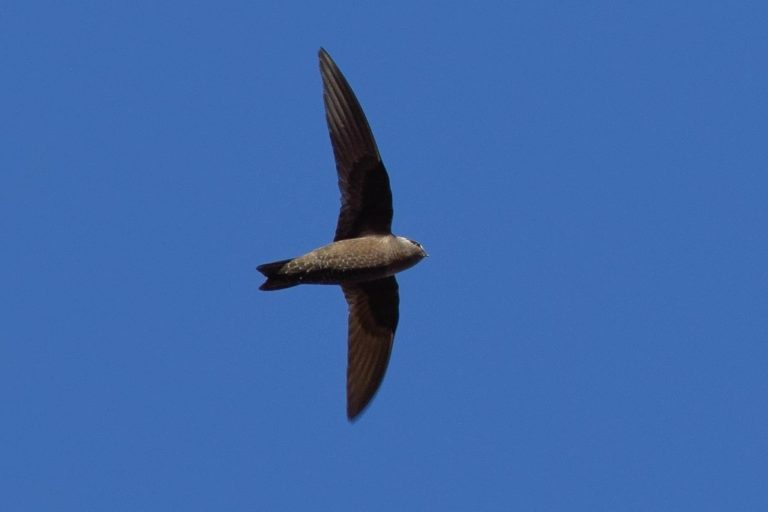
American Black Swift, C. n. borealis, showing apparent pale spotting on the belly and flanks. (Bauer Reservoir, Mancos, Colorado; June 9, 2018.) © David Tønnessen
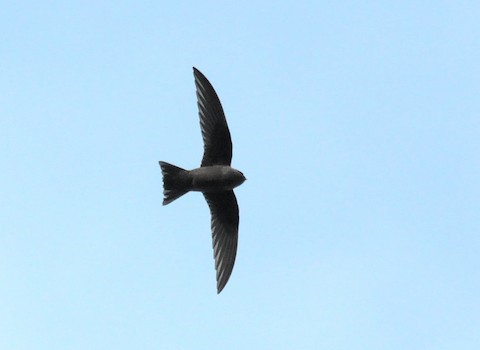
American Black Swift, C. n. borealis, with tail appearing shallowly forked when partly spread. (Port Susan Bay Preserve, Stanwood, Washington; June 3, 2010.) © Steven Mlodinow

American Black Swift, C. n. borealis, with tail appearing rounded when fully fanned. (Pemberton, British Columbia; June 28, 2019.) © Russ Morgan
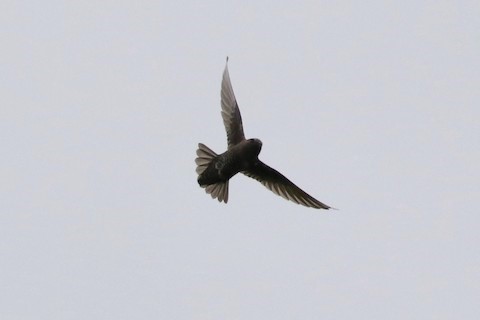
American Black Swift, C. n. borealis, with tail appearing rounded when fully fanned. (Pemberton, British Columbia; June 28, 2019.) © Russ Morgan

American Black Swift, C. n. borealis, with wings bowed, showing only a slight notch in folded tail. (Central Saanich, British Columbia; August 3, 2020.) © Daniel Donnecke
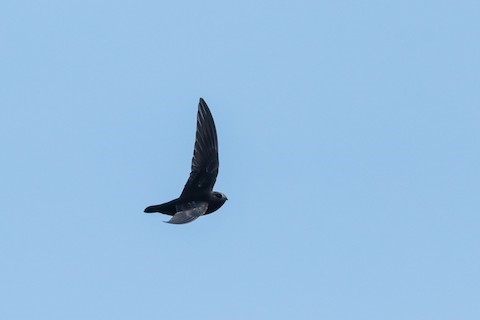
American Black Swift, C. n. borealis, appearing atypically short and plump. (Stanley Park, Vancouver, British Columbia; July 23, 2019.) © Frank Lin

American Black Swift, C. n. borealis, appearing atypically short and plump. (Vancouver, British Columbia; June 7, 2020.) © Bridget Spencer
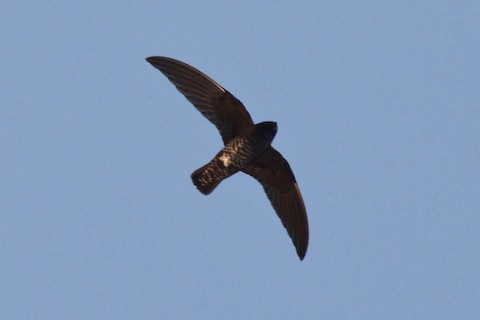
American Black Swift, C. n. borealis, showing pale spotting and a white belly-band, and tail appearing rounded when folded. (Sepulveda Basin Wildlife Reserve, Van Nuys, California; May 18, 2018.) © Daniel Tinoco
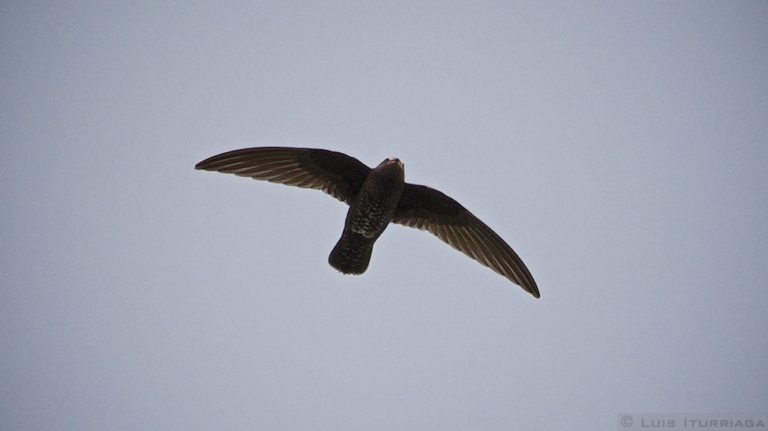
American Black Swift, C. n. borealis, with tail appearing rounded. (Desembocadura Río Jamapa y Arroyo Moreno, Veracruz, Mexico; July 3, 2017.) © Luis Iturriaga Morales

American Black Swift, C. n. borealis, showing characteristically long wings, long body and notched tail. (Wilder Ranch State Park, Santa Cruz, California; July 15, 2020.) © Michael Bolte
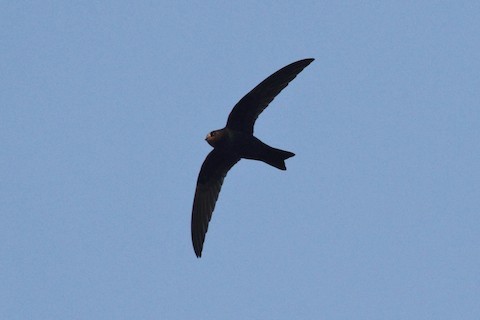
American Black Swift, C. n. borealis, showing characteristic flight silhouette: long wings, long body, and notched tail. (Sepulveda Basin Wildlife Reserve, Van Nuys, California; May 18, 2018.) © Daniel Tinoco
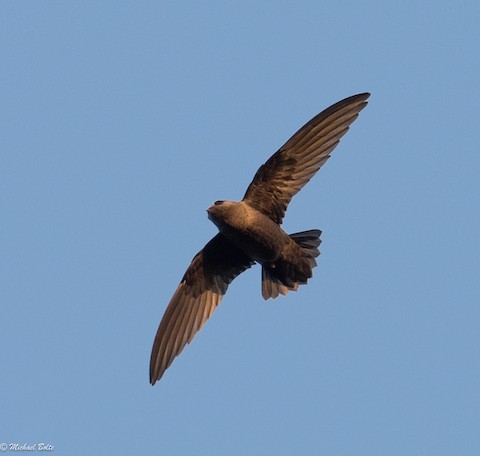
American Black Swift, C. n. borealis, showing somewhat paler throat in this lighting, and tail appearing rounded when fanned out. (Wilder Ranch State Park, Santa Cruz, California; June 6, 2017.) © Michael Bolte
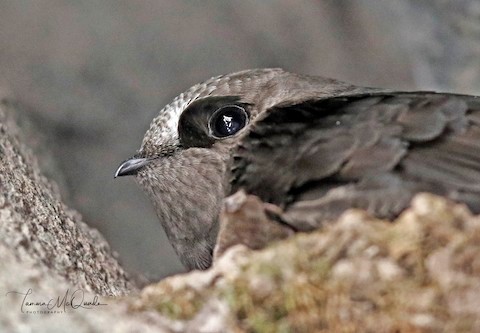
American Black Swift, C. n. borealis, showing paler forehead and brow area. (Box Canyon Falls Park, Ouray, Colorado; July 4, 2018.) © Tammy McQuade
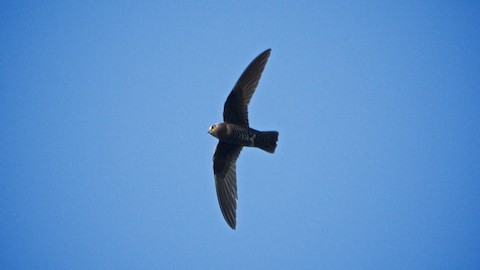
American Black Swift, C. n. borealis, showing pale spotting on the belly and tail appearing square when partly spread. (Desembocadura Río Jamapa y Arroyo Moreno, Veracruz, Mexico; June 18, 2016.) © Luis Iturriaga Morales

American Black Swift, C. n. borealis, showing somewhat paler throat and whitish forehead in this lighting, and characteristic flight silhouette: long wings, long body, and notched tail. (Bauer Reservoir, Mancos, Colorado; June 9, 2018.) © David Tønnessen
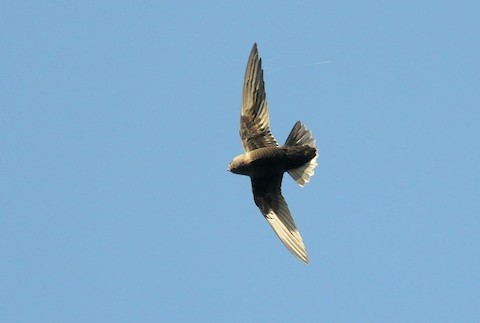
American Black Swift, C. n. borealis, showing how the angle of lighting can affect apparent coloration, and tail appearing rounded when fanned out. (Port Susan Bay Preserve, Stanwood, Washington; June 3, 2010.) © Steven Mlodinow
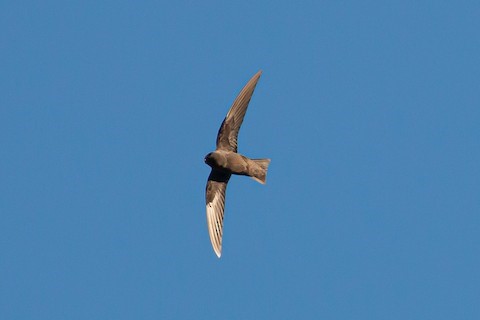
American Black Swift, C. n. borealis, with tail appearing shallowly forked when partly spread. (Claremont Wilderness Park, Claremont, California; July 28, 2020.) © David Coates

American Black Swift, C. n. borealis, showing pale spotting and a white belly-band, and appearing atypically short, stout, and square-tailed. (La Mina, Durango, Mexico; June 26, 2016.) © Amy McAndrews

American Black Swift, C. n. borealis, with wings held out straight and tail appearing rounded or square when folded. (Sechelt, British Columbia; July 9, 2007.) © Jukka Jantunen
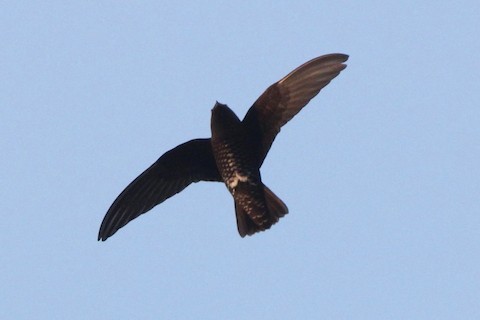
American Black Swift, C. n. borealis, showing pale spotting and a white belly-band, and tail appearing square when partly spread. (Sepulveda Basin Wildlife Reserve, Van Nuys, California; May 18, 2018.) © Daniel Tinoco
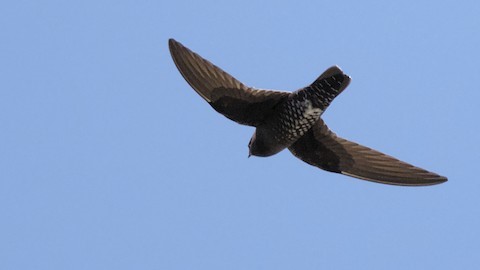
American Black Swift, C. n. borealis, showing pale spotting and a white belly-band, and tail appearing square when folded. (Piute Ponds, Rosamond, California; May 12, 2018.) © Mark Scheel
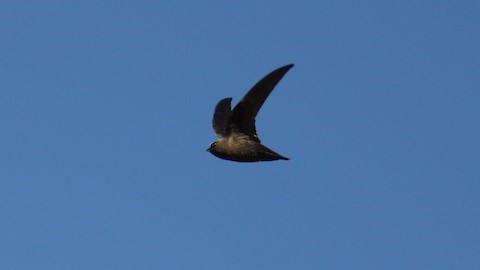
American Black Swift, C. n. borealis, appearing atypically short and plump. (Fresno, California; May 11, 2010.) © Jim Tietz
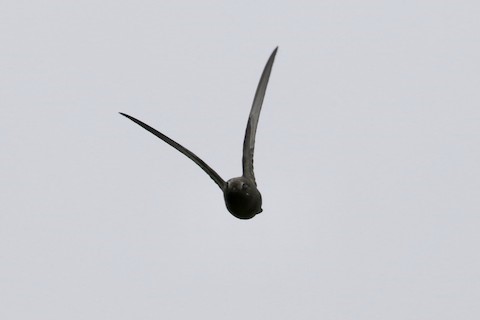
American Black Swift, C. n. borealis, head-on. (Pemberton, British Columbia; June 28, 2019.) © Russ Morgan
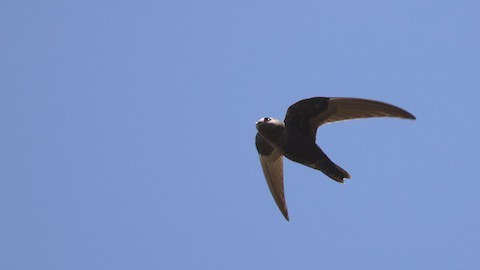
American Black Swift, C. n. borealis, showing characteristically long wings, long body and notched tail. (Piute Ponds, Rosamond, California; May 12, 2018.) © Mark Scheel
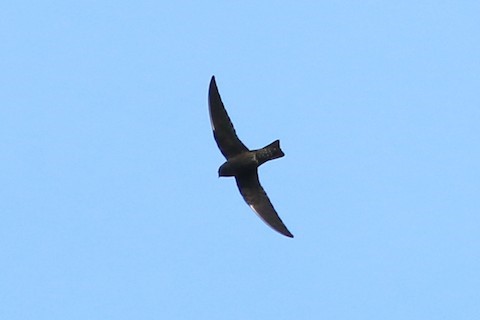
American Black Swift, with tail appearing shallowly forked when partly spread. (Alajuela, Costa Rica; April 21, 2020.) © David Garrigues
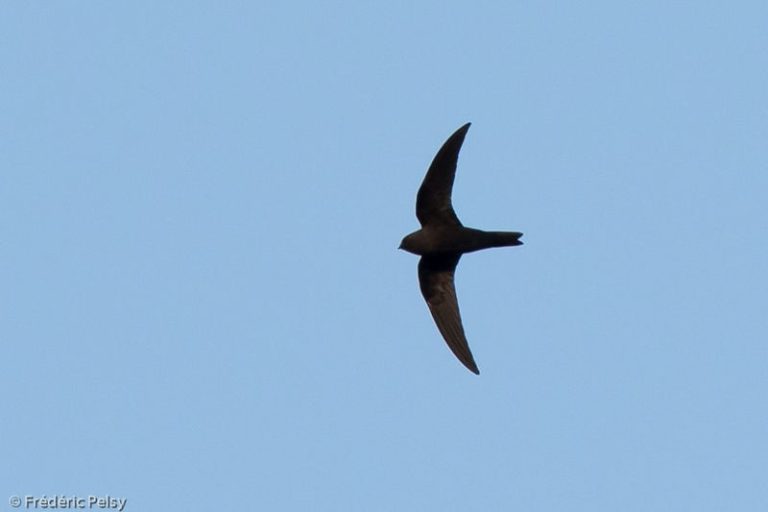
American Black Swift, C. n. niger, appearing jet-black and showing characteristic flight silhouette: long wings, long body, and notched tail. (Alcoa Road, Dominican Republic; March 31, 2017.) © Frédéric Pelsy

American Black Swift, C. n. borealis. (Box Canyon Falls Park, Ouray, Colorado; July 9, 2015.) © Aaron Maizlish

American Black Swift, C. n. borealis. (Box Canyon Falls Park, Ouray, Colorado; July 4, 2018.) © David McQuade
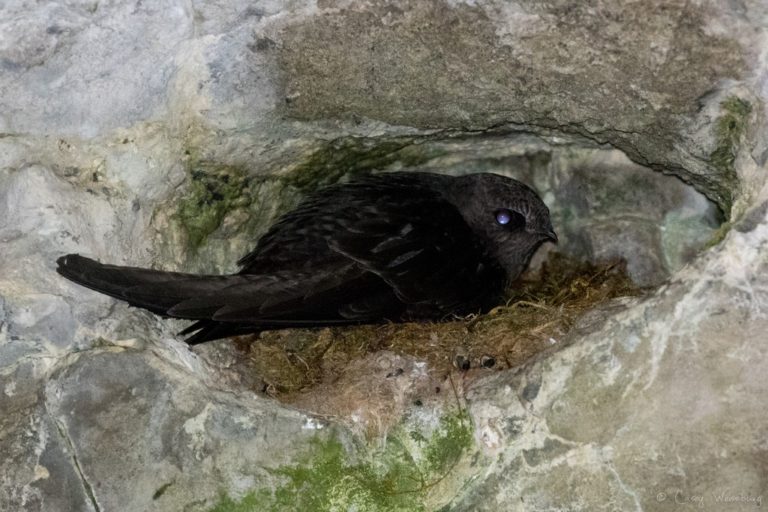
American Black Swift, C. n. borealis. (Banff National Park, Alberta; July 31, 2018.) © Casey Weissburg
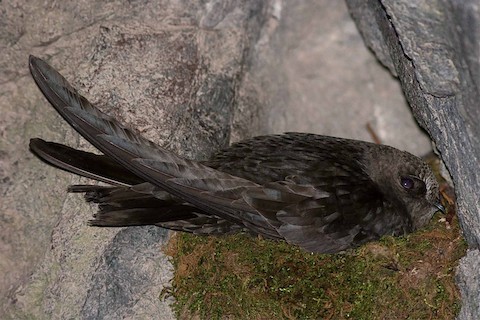
American Black Swift, C. n. borealis. (Box Canyon Falls Park, Ouray, Colorado; July 21, 2008.) © Michael O’Brien
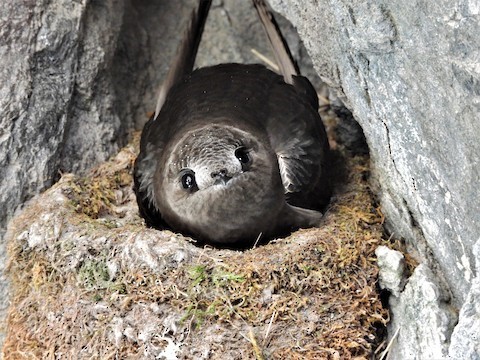
American Black Swift, C. n. borealis. (Box Canyon Falls Park, Ouray, Colorado; June 26, 2019.) © Chao “Jimmy” Wu

American Black Swift, C. n. borealis. (Box Canyon Falls Park, Ouray, Colorado; July 4, 2018.) © David McQuade

American Black Swift, C. n. borealis. (Box Canyon Falls Park, Ouray, Colorado; July 8, 2019.) © Oliver Burrus
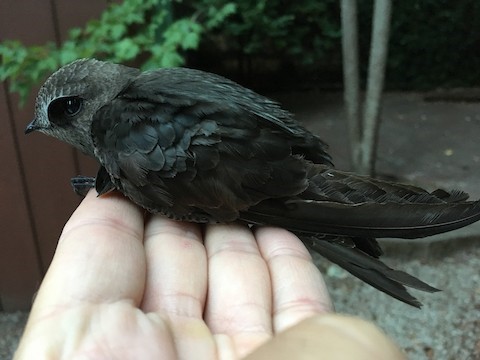
American Black Swift, C. n. borealis. (Santa Cruz, California; September 14, 2013.) © Craig Fosdick
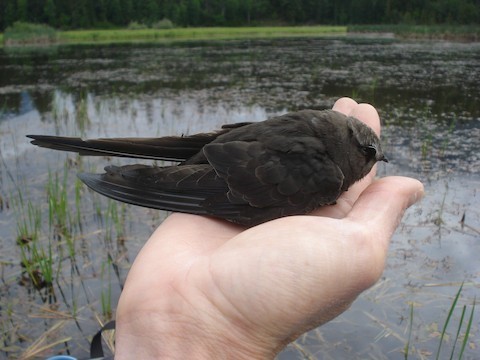
American Black Swift, C. n. borealis. (Airport Lake, Revelstoke, British Columbia; May 31, 2012.) © James Bradley

American Black Swift, C. n. borealis, apparently a juvenile with white tips on fresh feathers. (Zapata Falls, Alamosa County, Colorado; September 12, 2016.) © Spring Fed Images
Cf. White-chinned Swift. From Belize to Amazonia, American Black and White-chinned Swifts potentially overlap—and the extent of such overlap is poorly understood as both are seen infrequently and they can be extremely difficult to distinguish under most viewing conditions. Size and plumage differences between them are slight, but under some circumstances positive identification is possible.
American Black Swift is about 2 to 3 cm longer (about 18 cm versus 15 cm) and its wingspan is about 5 to 6 cm longer (about 36 cm versus 30 cm) than White-chinned. In absolute terms, these differences are difficult to evaluate, but the result is that American Black appears leaner, proportionately longer-winged and long-tailed.
American Black Swift usually shows a notch in its tail, when folded. White-chinned usually shows a square tail, when folded. However, some American Blacks show little or no notch, and White-chinned sometimes shows a slight notch, so this feature is not completely diagnostic.
Both American Black and White-chinned can show contrastingly pale areas on the face. On American Black, this usually includes the whole forehead and brow area. On White-chinned the paler areas are usually concentrated in front of each eye and very narrowly on the chin.
Cf. White-fronted Swift. In southwestern Mexico, American Black Swift overlaps with the rare, little-known White-fronted Swift. They are similar in shape and overall coloration, though White-fronted is significantly smaller (closer to Chaetura size) and would rarely if ever show a notched tail. White-fronted also differs in having a well-defined white (not just whitish) forehead and chin.
Cf. Female Chestnut-collared Swift. From northwestern Mexico to Trinidad, the Guianas, and Amazonia, American Black Swift overlaps with Chestnut-collared. They are similar in shape, including the notched tail, though Chestnut-collared is significantly smaller (closer to Chaetura size). In good light, male Chestnut-collared is easily distinguished by its chestnut collar, but female Chestnut-collared often shows no collar and can easily be mistaken for American Black.
Notes
Polytypic species consisting of three recognized subspecies.
IUCN Red List Status: Vulnerable.
References
Alderfer, J., and J.L. Dunn. 2014. National Geographic Complete Birds of North America (Second Edition). National Geographic Society, Washington, D.C.
BirdLife International. 2018. Cypseloides niger. The IUCN Red List of Threatened Species 2018: e.T22686440A131893534. (Accessed September 12, 2020.)
Chantler, P. 2000. Swifts: A Guide to the Swifts and Treeswifts of the World (Second Edition). Yale University Press.
eBird. 2020. eBird: An online database of bird distribution and abundance. Cornell Lab of Ornithology, Ithaca, N.Y. http://www.ebird.org. (Accessed September 11, 2020.)
Fagan, J., and O. Komar. 2016. Peterson Field Guide to the Birds of Northern Central America. Houghton Mifflin Harcourt, New York.
ffrench, R. 2012. A Guide to the Birds of Trinidad & Tobago (Third Edition). Cornell University Press. Ithaca, N.Y.
Garrigues, R., and R. Dean. 2014. The Birds of Costa Rica: A Field Guide (Second Edition). Cornell University Press.
Haynes-Sutton, A., A. Downer, R. Sutton, and Y.-J. Rey-Millet. 1986. A Photographic Guide to the Birds of Jamaica. Princeton University Press.
Howell, S.N.G., and S. Webb. 1995. A Guide to the Birds of Mexico and Northern Central America. Oxford University Press.
Kirwan, G.M., A. Levesque, M. Oberle, and C.J. Sharpe. 2019. Birds of the West Indies. Lynx Edicions, Barcelona.
Latta, S., C. Rimmer, A. Keith, J. Wiley, H. Raffaele, K. McFarland, and E. Fernandez. 2006. Birds of the Dominican Republic and Haiti. Princeton University Press.
McMullan, M., and T. Donegan. 2014, Field Guide to the Birds of Colombia (Second Edition). Fundación Proaves de Colombia, Bogotá.
Opar, A. 2012. Out of the Shadows: Black Swifts, North America’s Most Mysterious Birds. Audubon, https://www.audubon.org/magazine/september-october-2012/out-shadows-black-swifts-north.
Raffaele, H., J. Wiley, O. Garrido, A. Keith, and J. Raffaele. 1998. A Guide to the Birds of the West Indies. Princeton University Press, Princeton, N.J.
Ridgely, R.S., and J.A. Gwynne. 1989. A Guide to the Birds of Panama (Second Edition). Princeton University Press.
Salt, W.R., and J.R. Salt. 1976. The Birds of Alberta. Hurtig Publishers, Edmonton, Alberta.
Schulenberg, T.S., D.F. Stotz, D.F. Lane, J.P. O’Neill, and T.A. Parker. 2007. Birds of Peru. Princeton University Press.
Sibley, D.A. 2000. The Sibley Guide to Birds. Alfred A. Knopf. New York.
Stiles, F.G., and A.J. Negret. 1994. The Nonbreeding Distribution of the Black Swift: A Clue from Colombia and Unsolved Problems. Condor 96, 1091-1094.
Xeno-Canto. 2020. American Black Swift – Cypseloides niger. https://www.xeno-canto.org/species/Cypseloides-niger. (Accessed September 12, 2020.)
